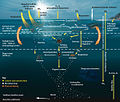Carbon sequestration
Carbon sequestration is the process by which carbon dioxide (CO2) is captured from the atmosphere and stored to mitigate global warming and climate change. This process can occur naturally, such as through photosynthesis in plants, or it can be artificially induced through various technologies.
Natural Carbon Sequestration[edit]
Natural carbon sequestration occurs primarily through the process of photosynthesis in plants and phytoplankton. These organisms absorb CO2 from the atmosphere and convert it into organic matter, such as glucose, through the process of photosynthesis. When these organisms die and decompose, the carbon they have absorbed is transferred to the soil or the ocean floor, where it can remain sequestered for hundreds to thousands of years.
Artificial Carbon Sequestration[edit]
Artificial carbon sequestration involves the use of technology to capture and store CO2. This can be done in several ways, including carbon capture and storage (CCS), carbon capture and utilization (CCU), and bio-energy with carbon capture and storage (BECCS).
CCS involves capturing CO2 emissions from large point sources, such as power plants, and transporting it to a storage site where it is injected into the ground. CCU, on the other hand, involves capturing CO2 and converting it into useful products, such as fuels, chemicals, and building materials. BECCS involves the combination of bioenergy production with CCS, resulting in net negative emissions.
Challenges and Controversies[edit]
While carbon sequestration has the potential to significantly reduce greenhouse gas emissions, it also presents several challenges and controversies. These include the high cost of CCS technologies, the risk of CO2 leakage from storage sites, and the potential for increased demand for biomass in BECCS to lead to land use changes and biodiversity loss.
See Also[edit]
- Climate change mitigation
- Greenhouse gas
- Carbon capture and storage
- Carbon capture and utilization
- Bio-energy with carbon capture and storage
References[edit]
<references />

This article is a environment-related stub. You can help WikiMD by expanding it!
-
Carbon sequestration
-
Proportion of carbon stock in forest carbon pools, 2020
-
Wetland in Skippack Township, MontCo PA
-
Carbon sequestration
-
Panicum virgatum heavy metal switch grass MN 2007
-
Charcoal
-
Oceanic Food Web
-
Kelp Forest
-
Seagrass at Rapid Bay Jetty
-
Women working with seaweed in Zanzibar
-
Phytoplankton in the South Atlantic
Ad. Transform your life with W8MD's Budget GLP-1 injections from $75


W8MD offers a medical weight loss program to lose weight in Philadelphia. Our physician-supervised medical weight loss provides:
- Weight loss injections in NYC (generic and brand names):
- Zepbound / Mounjaro, Wegovy / Ozempic, Saxenda
- Most insurances accepted or discounted self-pay rates. We will obtain insurance prior authorizations if needed.
- Generic GLP1 weight loss injections from $75 for the starting dose.
- Also offer prescription weight loss medications including Phentermine, Qsymia, Diethylpropion, Contrave etc.
NYC weight loss doctor appointmentsNYC weight loss doctor appointments
Start your NYC weight loss journey today at our NYC medical weight loss and Philadelphia medical weight loss clinics.
- Call 718-946-5500 to lose weight in NYC or for medical weight loss in Philadelphia 215-676-2334.
- Tags:NYC medical weight loss, Philadelphia lose weight Zepbound NYC, Budget GLP1 weight loss injections, Wegovy Philadelphia, Wegovy NYC, Philadelphia medical weight loss, Brookly weight loss and Wegovy NYC
|
WikiMD's Wellness Encyclopedia |
| Let Food Be Thy Medicine Medicine Thy Food - Hippocrates |
Medical Disclaimer: WikiMD is not a substitute for professional medical advice. The information on WikiMD is provided as an information resource only, may be incorrect, outdated or misleading, and is not to be used or relied on for any diagnostic or treatment purposes. Please consult your health care provider before making any healthcare decisions or for guidance about a specific medical condition. WikiMD expressly disclaims responsibility, and shall have no liability, for any damages, loss, injury, or liability whatsoever suffered as a result of your reliance on the information contained in this site. By visiting this site you agree to the foregoing terms and conditions, which may from time to time be changed or supplemented by WikiMD. If you do not agree to the foregoing terms and conditions, you should not enter or use this site. See full disclaimer.
Credits:Most images are courtesy of Wikimedia commons, and templates, categories Wikipedia, licensed under CC BY SA or similar.
Translate this page: - East Asian
中文,
日本,
한국어,
South Asian
हिन्दी,
தமிழ்,
తెలుగు,
Urdu,
ಕನ್ನಡ,
Southeast Asian
Indonesian,
Vietnamese,
Thai,
မြန်မာဘာသာ,
বাংলা
European
español,
Deutsch,
français,
Greek,
português do Brasil,
polski,
română,
русский,
Nederlands,
norsk,
svenska,
suomi,
Italian
Middle Eastern & African
عربى,
Turkish,
Persian,
Hebrew,
Afrikaans,
isiZulu,
Kiswahili,
Other
Bulgarian,
Hungarian,
Czech,
Swedish,
മലയാളം,
मराठी,
ਪੰਜਾਬੀ,
ગુજરાતી,
Portuguese,
Ukrainian









